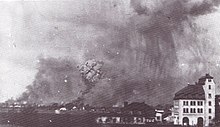Rothenstein (Koenigsberg)
Rothenstein was a village and a settlement in Koenigsberg , today's Kaliningrad . Königsberg-Rothenstein was at 3.6 km the railway station of the Königsberg – Cranz railway line , which ran from Königsberg to Cranz (today: Zelenogradsk ) on the Baltic Sea .
Rothenstein accidents
An ammunition factory was located north of Maraunenhof . It exploded for the first time on August 4, 1916. 44 people were killed and 95 injured.
The large explosion of stored ammunition on April 10, 1920 caused considerable damage in the city center of Königsberg. The dome of the crematorium with the frescoes by Otto Ewel collapsed. “When General Reinhardt wanted to inspect the newly established Reichswehr in Quednau, a battalion that he was about to greet fell forward on the nose. At the same time the crack of a violent discharge could be heard. The nearby ammunition factory in Rothenstein had blown up. ” Siegfried Thomaschki helped rescue the injured .
Rothenstein internment camp of the NKVD in 1945
Shortly after the conquest of Königsberg by the Red Army in 1945 , the NKVD set up an internment camp for thousands of politically suspicious German civilians, for men and women, in the buildings of the Rothenstein barracks complex . One inmate was the violinist Michael Wieck , who always speaks of the Rothenstein concentration camp in his book Testimony to the Fall of Königsberg . The horrific conditions in the camp are also described by the doctor Hans Graf von Lehndorff , who had to experience them from April to June 1945 and recorded them in his East Prussian diary . The internees were extremely crowded together, had no place to lie down, had no sanitary facilities, and died en masse from the effects of hunger, cold, abuse, dysentery and other illnesses. The cellars under all the barracks were filled with around 4,000 men and women who were interrogated every night under mental and physical torture. Many died during or after the interrogations, and some were beaten to death. The troubled people turned into terrible grimaces, gray newts.
The architect Frank Lortzing, the son-in-law of Pastor Beckmann, died there in mid-April 1945.
literature
- Siegfried Schindelmeiser: The Albertina and its students 1544 to WS 1850/51 and the history of the Corps Baltia II zu Königsberg i. Pr. (1970-1985). For the first time complete, illustrated and commented new edition in two volumes with an appendix, two registers and a foreword by Franz-Friedrich Prinz von Preussen, edited by R. Döhler and G. v. Klitzing, Munich 2010. ISBN 978-3-00-028704-6
- Hans Graf von Lehndorff: East Prussian diary. Doctor's notes from 1945-1947 . dtv Munich, 31st edition 2010, corresponding to the unabridged edition from 1967. ISBN 978-3-423-30094-0
- Michael Wieck: Testimony to the fall of Königsberg. A prominent Jew reports . Beck-Verlag, Munich. 2nd edition 2009. ISBN 978-3-406-59599-8
Web links
Individual evidence
- ^ A b Robert Albinus: Königsberg Lexicon. Würzburg 2002, p. 156
- ↑ Schindelmeiser, vol. 2, p. 201 f.
- ^ Hans Graf von Lehndorff: East Prussian Diary . dtv Munich, 31st edition 2010, pp. 104–137. ISBN 978-3-423-30094-0
- ^ Hugo Link "Königsberg 1945-1948".
Coordinates: 54 ° 44 ′ 17 ″ N , 20 ° 31 ′ 42 ″ E
